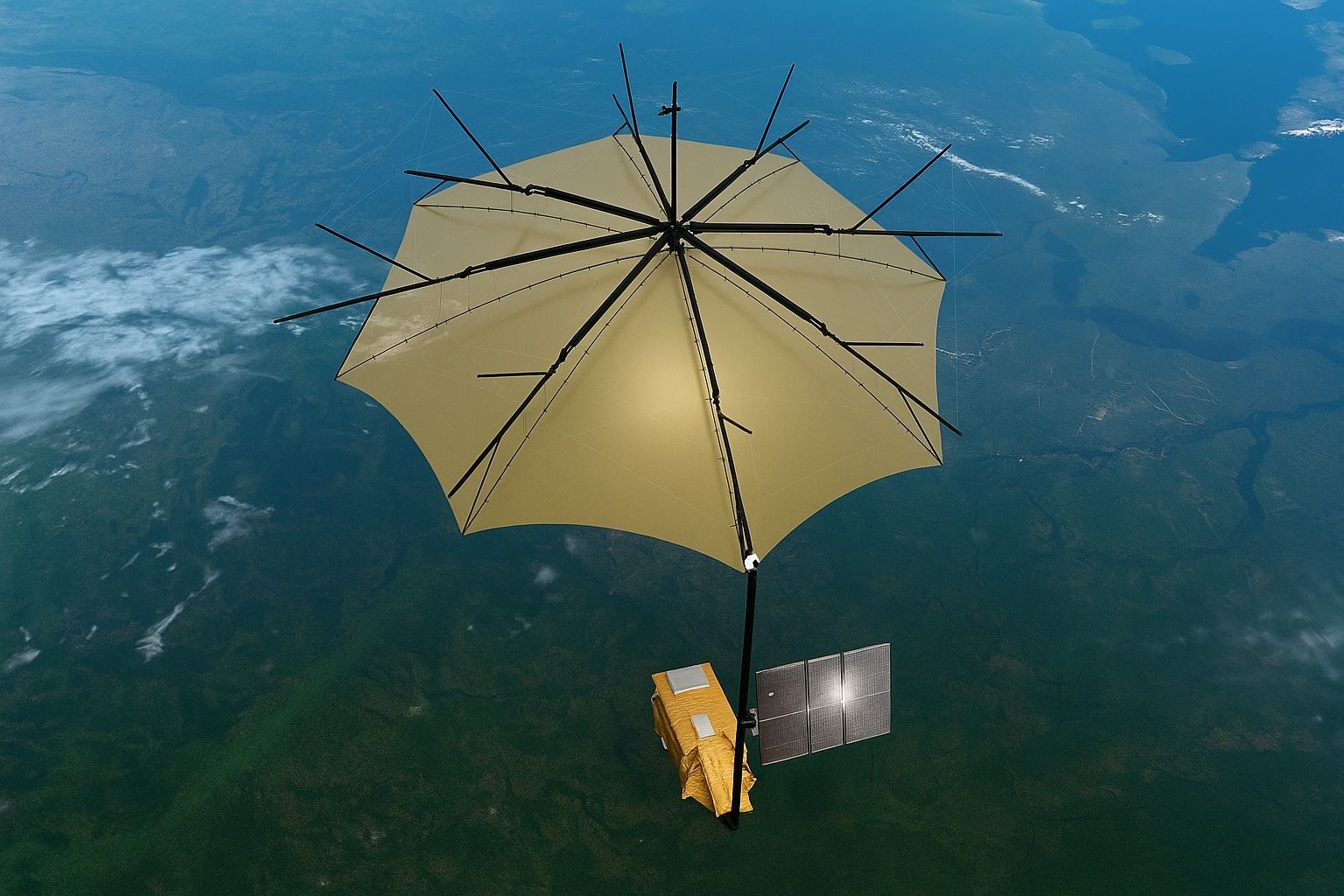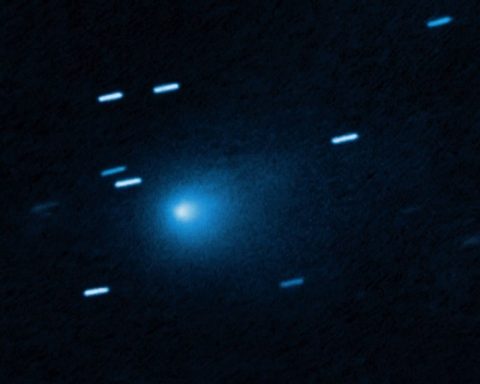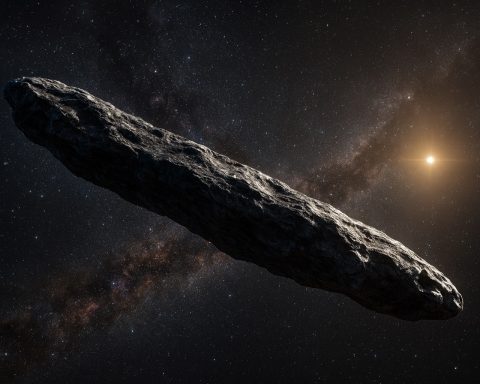- The ESA Biomass satellite, launched on April 29, 2025, carries the first P-band synthetic aperture radar (435 MHz) to map the world’s forests in 3D and quantify their carbon content.
- The mission uses a 12-meter deployable antenna—the largest radar antenna ever flown—to enable detection of biomass changes as small as 10–20 tons per hectare.
- Biomass operates in a polar Sun-synchronous orbit at about 666 km altitude for a five-year lifespan, scanning tropical, temperate, and boreal forests globally.
- The long-wavelength P-band radar (about 70 cm) penetrates dense foliage to measure forest height, volume, and biomass from canopy to trunk to ground.
- During an initial 18-month phase, Biomass will gather multi-angle data to derive a structural ‘twin’ of the world’s forests at about 200 m resolution, mapping canopy and vertical biomass distribution.
- The mission’s data will support international climate treaties and carbon markets by providing authoritative forest carbon measurements for REDD+ and Paris Agreement reporting.
- Beyond forests, Biomass can penetrate deserts up to 5 meters below dry sand, detecting buried paleo-aquifers and ancient riverbeds.
- In polar ice, P-band radar penetrates deep into ice sheets, and an image of Antarctica’s Nimrod Glacier demonstrated the radar’s ability to see beneath surface snow and hint at ice-flow dynamics.
- A Biomass Calibration Transponder on the ground in New Norcia, Australia—a 5-meter dish antenna built by IDS (Italy) and C-CORE (Canada)—will calibrate the space antenna during a six-month commissioning phase, with periodic checks about twice a year.
- To avoid interference with U.S. space object-tracking radars, Biomass will not collect data over parts of North America and Europe, illustrating the coordination challenges of using a novel frequency from orbit.
A New Radar Eye for Forest Carbon
The European Space Agency’s Biomass satellite, launched on April 29, 2025, is a groundbreaking mission designed to map the world’s forests in 3D and measure their carbon content with unprecedented accuracy [1] [2]. It is the first satellite ever to carry a P-band synthetic aperture radar – a long-wavelength radar around 435 MHz – which allows it to “see” through dense vegetation much like an X-ray, reaching the woody trunks and branches where most of a forest’s carbon is stored [3] [4]. Operating from a polar Sun-synchronous orbit ~666 km above Earth, this Earth Explorer mission will scan tropical, temperate, and boreal forests globally over its five-year lifespan [5] [6]. The spacecraft’s massive 12-meter deployable antenna (the largest ever flown for a radar) is key to its sensitivity, enabling detection of biomass changes as small as 10–20 tons per hectare [7] [8]. Together, these innovations mark a “revolution in forest carbon monitoring,” offering high-quality global biomass maps that were previously impossible [9] [10].
Such capabilities come at a critical time. Forests are vital carbon sinks – tropical forests alone hold about one-third of all terrestrial carbon – but deforestation and degradation are releasing billions of tonnes of CO₂ back into the atmosphere [11] [12]. Traditional ground surveys and optical satellites have struggled to accurately measure forest biomass, especially in remote and cloudy regions [13] [14]. ESA’s Biomass is engineered to overcome these hurdles. By using active radar pulses rather than sunlight, it can collect data day or night and through clouds, ensuring consistent year-round monitoring [15] [16]. Its long wavelength means it doesn’t just image the treetops like previous satellites – it penetrates the canopy to capture the full 3D structure of forests, from canopy to trunk to ground [17] [18]. The result will be the first detailed global inventory of above-ground forest biomass and carbon, updated on a regular basis.
Peering Through Canopies, Sand, and Ice with P-Band SAR
Biomass’s P-band radar provides a form of “X-ray vision” that can probe environments opaque to other sensors. Forests: The radar waves (with ~70 cm wavelength) penetrate dense foliage, interacting with large tree trunks and branches instead of just leaves. This allows Biomass to measure forest height, volume, and biomass even in the deepest rainforests. In fact, by combining multiple radar observations from slightly different angles, the mission performs radar tomography – building a 3D model of the forest similar to a CT scan [19] [20]. During an initial 18-month phase, Biomass will gather multi-angle data to derive a structural “twin” of the world’s forests at ~200 m resolution, mapping not only canopy cover but the vertical distribution of biomass [21] [22]. This unique sampling technique means the true strength of the mission is not single images but the ability to combine observations to reveal forest height and biomass – enabling scientists to quantify carbon stocks far more accurately [23] [24].
This long wavelength “super power” isn’t limited to forests. Deserts: Biomass’s radar can penetrate up to 5 meters below dry sand, detecting buried features like ancient riverbeds and lakebeds in arid regions [25]. In one early image, the satellite revealed stunning sub-surface structures beneath the Sahara, indicating the location of paleo-aquifers (fossil water) and past climate conditions [26]. Such data could help in the search for groundwater in deserts and improve our understanding of how desert landscapes evolved [27] [28]. Ice: Likewise, P-band radar penetrates deeper into polar ice sheets than shorter wavelengths. Biomass can peer into the Antarctic ice, capturing information on internal layering and even measuring ice stream velocities – insights that conventional C-band or X-band radar satellites cannot easily obtain [29]. For example, an image of Antarctica’s Nimrod Glacier demonstrated the radar’s ability to see beneath surface snow, hinting at the flow dynamics and structure of the ice sheet below [30]. These secondary objectives (in deserts and ice) show how Biomass’s “X-ray vision” offers a new perspective on Earth’s extreme environments [31] [32], essentially providing a completely new view of Earth’s surface that extends well beyond forest applications [33] [34].
Calibration Challenges at 666 km Orbit
Deploying such an innovative radar in space comes with significant calibration challenges. At P-band frequencies, the Earth’s ionosphere can disturb the radar signals – causing delays, scattering, and Faraday rotation (twisting of the polarization) as the waves travel through Earth’s upper atmosphere [35]. Correcting these effects is essential for Biomass to produce accurate measurements. The mission compensates by using dual-polarization measurements and models of ionospheric conditions to adjust the data, ensuring that the radar echoes truly represent the ground targets and not atmospheric artifacts [36]. Another challenge is the sheer distance to target: orbiting at 666 km means the radar signals must travel a long path and back, so even tiny imperfections in the instrument can introduce errors when estimating forest biomass. Precise calibration of the radar’s timing, gain, and polarization is therefore critical.
To achieve this, ESA has deployed a custom Biomass Calibration Transponder on the ground in New Norcia, Australia [37] [38]. This is basically a “reference target” for the satellite: a 5-meter dish antenna housed in a protective radome that tracks the satellite’s pass and actively intercepts and retransmits the radar pulses back to space [39] [40]. By comparing the known signal sent by the transponder with what the satellite receives, engineers can fine-tune the radar’s performance. “The Biomass Calibration Transponder… is a much larger transponder than has been built for other SAR missions,” notes ESA, due to the very low P-band frequency and the need to calibrate the 12 m space antenna with extreme accuracy [41]. In fact, this ground device – developed by a team in Europe (IDS, Italy) and Canada (C-CORE) – had to be specially tested in ESA’s largest radiofrequency chamber to validate its performance [42] [43]. During the satellite’s six-month commissioning phase, the transponder will be used intensively to measure the radar’s characteristics and ensure its readings of biomass are on target [44]. Thereafter, periodic check-ups (about twice a year) will keep the instrument calibrated throughout the mission [45]. This careful calibration regimen, combined with internal calibration pulses and algorithmic corrections, is what makes Biomass’s data trustworthy. As ESA’s Biomass Project Manager Michael Fehringer explained during the first data reveal, the team is “fine-tuning the satellite to ensure it delivers the highest quality data for scientists to accurately determine how much carbon is stored in the world’s forests” [46] [47].
Notably, operating a P-band radar in space also required coordination to avoid conflicts with other users of this frequency. For example, to prevent interference with certain U.S. space object tracking radars, Biomass will not collect data over parts of North America and Europe – a compromise made during mission planning [48]. While this limits coverage in those regions, it underscores the complexity of using a novel frequency from orbit. Despite these hurdles – from orbital debris at 666 km to radio frequency coordination – the Biomass satellite is now in orbit and, according to ESA, “functioning smoothly” as it undergoes calibration and commissioning [49] [50]. Solving these challenges is a necessary step so that the mission’s data can be fully trusted by the scientific and policy communities.
3D Biomass Maps for Climate Treaties and Carbon Markets
The ultimate goal of the Biomass mission is to produce accurate 3D maps of forest biomass worldwide – and these maps are poised to become a cornerstone for international climate efforts and carbon markets. Forests play a crucial role in the global carbon cycle, so knowing exactly how much carbon is stored (and lost or gained) in forests is vital for climate policy. Climate treaties: Under the Paris Agreement and other accords, countries must report their greenhouse gas emissions and removals, including changes in forest carbon stocks. Until now, such reporting relied on rough estimates or sparse ground surveys, leading to large uncertainties. Biomass’s global data will “significantly improve the understanding of carbon storage, forest health, and temporal changes of forest ecosystems” [51] [52]. One of the mission’s stated objectives is to support international treaties and programs like the UN’s REDD+ (Reducing Emissions from Deforestation and Forest Degradation) by providing authoritative forest carbon measurements [53] [54]. In practice, this means countries implementing REDD+ or conservation pledges will have an independent, high-resolution benchmark to assess how well their forests are being protected or restored. The Biomass data will bolster “national climate reporting under the Paris Agreement,” making it more transparent and credible [55] [56]. In the words of Dr. Shaun Quegan, the mission’s lead scientist, “This is the first time we’ll have consistent, accurate measurements of forest biomass from space — data that’s essential for understanding and mitigating climate change.” [57].
Carbon markets: The rise of carbon credit programs – where forest conservation or reforestation is monetized as carbon offsets – makes reliable biomass data even more critical. Both compliance markets (regulated offsets) and the voluntary carbon market depend on knowing exactly how much CO₂ a forest absorbs or emits over time. “These measurements directly impact the credibility and value of offset projects,” note experts, since the number of carbon credits issued for a forest project must reflect real, verifiable carbon sequestration [58] [59]. If emissions reductions are overestimated due to poor data, carbon credits can be over-credited – undermining climate goals. High-integrity markets therefore demand transparent, accurate forest data:
- Baseline accuracy: You can’t issue carbon credits without knowing how much carbon is stored or added in a project area. Better biomass maps mean more accurate baselines and credit calculations [60] [61].
- Project integrity: Investors and regulators need confidence that claimed emissions reductions are genuine. Satellite-derived biomass data allows independent verification of forest growth or loss, improving trust in carbon credits [62].
- Ongoing monitoring: Forest carbon stocks can change quickly if logging or fire occurs. Biomass will provide updates every 6–12 months, so any reversals (like deforestation in a protected project) can be caught and the credits adjusted accordingly [63] [64]. Continuous monitoring ensures credits remain aligned with reality, not just a one-time estimate.
- Scaling up: As demand for nature-based credits grows, having globally consistent data from space enables new projects in remote, data-poor regions [65]. It lowers the cost and uncertainty of measuring carbon in, say, the Congo Basin or Papua New Guinea, thus helping carbon finance reach these areas responsibly.
In short, Biomass’s 3D forest maps will provide a common, science-based yardstick for carbon accounting, whether for international treaty compliance or market transactions. By reducing uncertainty in estimates of forest carbon flux, the mission will improve the integrity of climate solutions that rely on forests [66] [67]. Alain Fauré of Airbus Defence and Space pointed out that “Biomass will give scientists and climatologists unprecedented data on the state of the world’s forests, further enhancing the understanding of the climate cycle.” [68] This unprecedented visibility into forest carbon is arriving none too soon. With deforestation still rampant in parts of the world, having the means to precisely monitor forest loss and regrowth is crucial for enforcing conservation policies and incentivizing sustainable management [69] [70].
The revolution in carbon accounting that Biomass promises is not just about cool radar technology – it’s about empowering better climate action. Governments will be able to track progress toward emission-reduction targets with confidence in the forest sector. Conservation organizations will have concrete data to identify hotspots of forest change and verify if protection efforts are working. Carbon market participants will transact with better knowledge of what they are buying or selling. As one sustainability technologist observed, “high-resolution, reliable data on carbon stocks will empower governments, scientists, and conservationists” to ramp up efforts against climate change [71] [72]. In essence, accurate 3D biomass maps become the currency of trust in climate mitigation efforts involving forests.
Conclusion
With the Biomass satellite now in orbit and already returning striking early images, we stand at the dawn of a new era in forest monitoring. By lifting the veil off Earth’s forests – piercing through clouds, leaves, sand and ice – ESA’s P-band radar mission is delivering the data needed to manage our planet more wisely. This “X-ray vision” from space will help scientists count the carbon in remote jungles, help policymakers enforce climate agreements, and help markets invest in genuine nature-based solutions. The coming years will see the first high-quality global forest carbon inventory unfold, one radar swath at a time. As we witness this breakthrough, it’s clear that seeing the woods and the trees – in all their three-dimensional complexity – will illuminate the path toward better climate stewardship [73] [74]. The forests of Earth, often called the lungs of our planet, can now be measured and monitored with a new level of clarity. And with that clarity comes power – the power to protect these critical ecosystems and the climate they influence, armed with facts and not just estimates. The ESA Biomass mission is indeed a giant leap for environmental science, giving us an eye in the sky with the vision to safeguard our forests and our future.
Sources: The information and quotations in this report are drawn from recent ESA publications, mission press releases, and expert analyses, including ESA’s official Biomass mission announcements [75] [76], the first images released at the 2025 Living Planet Symposium [77] [78], industry commentary by mission collaborators [79] [80], and insights from climate and forestry experts evaluating Biomass’s impact on carbon monitoring [81] [82]. These sources reflect the state-of-the-art understanding as of mid-2025, when the Biomass satellite began its pioneering quest to map Earth’s forests for the benefit of climate science and policy.
References
1. defensetalks.com, 2. www.airbus.com, 3. www.jpost.com, 4. www.linkedin.com, 5. defensetalks.com, 6. www.linkedin.com, 7. www.linkedin.com, 8. www.linkedin.com, 9. www.linkedin.com, 10. www.linkedin.com, 11. www.linkedin.com, 12. www.linkedin.com, 13. www.treeconomy.co, 14. www.treeconomy.co, 15. www.treeconomy.co, 16. www.treeconomy.co, 17. www.esa.int, 18. www.esa.int, 19. www.treeconomy.co, 20. www.esa.int, 21. www.treeconomy.co, 22. www.treeconomy.co, 23. www.esa.int, 24. www.esa.int, 25. www.esa.int, 26. www.esa.int, 27. www.esa.int, 28. www.esa.int, 29. www.esa.int, 30. www.esa.int, 31. defensetalks.com, 32. www.airbus.com, 33. www.airbus.com, 34. www.airbus.com, 35. agupubs.onlinelibrary.wiley.com, 36. www.esa.int, 37. en.wikipedia.org, 38. www.esa.int, 39. www.esa.int, 40. www.esa.int, 41. www.esa.int, 42. www.esa.int, 43. www.esa.int, 44. en.wikipedia.org, 45. en.wikipedia.org, 46. www.esa.int, 47. www.esa.int, 48. en.wikipedia.org, 49. www.esa.int, 50. www.esa.int, 51. en.wikipedia.org, 52. en.wikipedia.org, 53. en.wikipedia.org, 54. en.wikipedia.org, 55. www.linkedin.com, 56. www.linkedin.com, 57. www.linkedin.com, 58. www.treeconomy.co, 59. www.treeconomy.co, 60. www.treeconomy.co, 61. www.treeconomy.co, 62. www.treeconomy.co, 63. www.treeconomy.co, 64. www.treeconomy.co, 65. www.treeconomy.co, 66. www.linkedin.com, 67. www.treeconomy.co, 68. defensetalks.com, 69. defensetalks.com, 70. www.linkedin.com, 71. www.linkedin.com, 72. www.linkedin.com, 73. www.esa.int, 74. www.linkedin.com, 75. www.airbus.com, 76. www.airbus.com, 77. www.esa.int, 78. www.esa.int, 79. defensetalks.com, 80. www.esa.int, 81. www.linkedin.com, 82. www.treeconomy.co










